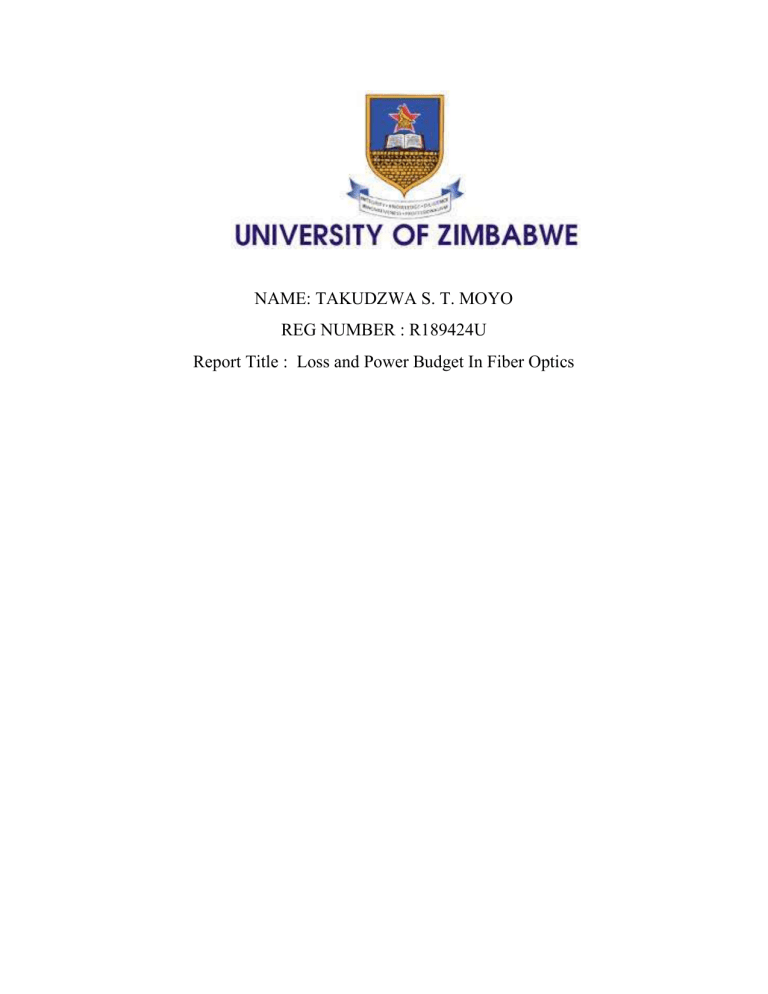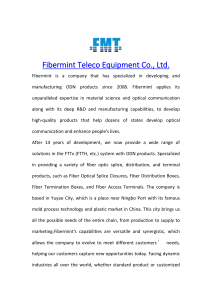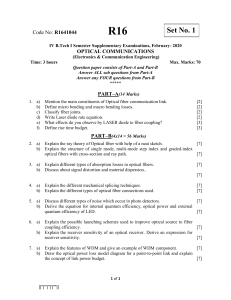
NAME: TAKUDZWA S. T. MOYO REG NUMBER : R189424U Report Title : Loss and Power Budget In Fiber Optics 1 Objectives To investigate the effect of loss on optical system performance and characterize the system with the power budget equation. To use Optisystem software to optimize the fiber length of a communication system 2 Background Light signals lose power as they travel from optical transmitter to optical receiver. Loss of power is caused by many factors such as scattering, noise bending, dispersion and polarization in the optic fiber. Link power budget analysis is done in order to measure the performance of an optic fiber system. If the signal power at the receiver is less than the receiver sensitivity then the signal will not be received correctly. For a good signal at the receiver side the signal has to be greater than receiver sensitivity. Power margin is the received signal and the power sensitivity of the receiver. Power margin can be calculated by the following equation 𝑀 = 𝑃𝑡−𝑆𝑟 −𝐴𝐿𝑓−𝐿𝑐−𝐿𝑎, Where 𝑃𝑡 is transmitter power 𝐴𝐿𝑓 is fiber loss 𝐿𝑎 is additional loss 𝑆r is receiver sensitivity 𝐿𝑐 is coupler loss 𝑀 is power margin Power budget of an optical system can be done using software to design and virtually test an optical link. Optisystem is a cost effective and efficient software that can be used to simulate a fiber optic communication system. Method and Materials Materials Optisystem software was used to design the fiber communication system shown below in Fig 1. Figure 1: Fiber communication system 3 System Performance The power of the optical transmitter was correctly set to 2dBm and bit rate was set to 1 Gb/s To simulate a receiver with a -30 dBm sensitivity the PIN photodiode’s Thermal power density was set to 15e-24 W/Hz. The following components were placed: Optical Transmitter Optical Fiber Connector Gaussian Optical Filter Low Pass Gaussian Filter PIN Photodiode 3R Regenerator BER Analyzer Transmitters Library/Optical Transmitters Optical Fibers Library Passives Library/Optical/Connectors Filters Library/Optical Filters Library/Electrical Receivers Library/Photodetectors Receivers Library/Regenerators Visualizer Library/Electrical The optical fiber length was set to 1.67km and the project was simulated and a BER of 4.02 ∗ 10 was obtained as shown in graph below Figure 2: Graph of log of BER against Time 3.1 Effect of loss on system performance In the layout properties, the sequence length was changed from 128 to 1024 and a bit error rate value of 1.06 ∗ 10 was obtained as shown in the graph below Figure 3 : Graph of Q factor against time A parameter sweep of the optical fiber length was created and varied from 18 km to 25 km with 10 total steps Figure 4: Parameter sweeps from 18 to 25 km 3.2 Optisystem optimizations Starting from the same project file as used above, an optimization was run to determine the optimal bandwidth of the Gaussian filter First the parameter sweep was removed, by changing the fiber length parameter from sweep to normal and it was assigned a value of 23 km and the total number of sweep iterations to was set to 1. The objective of this optimization was to determine the best cutoff frequency for the low pass electrical filter. The optimizations window was opened by finding it in the Tools tab. Figure 5: Opening the optimizations window The SPO Optimization (Single Parameter Single Result) was chosen and Inserted. Figure 6 : Selecting the SPO Optimization from the Optimizations window. The properties were set. The goal for this optimization was to maximize the Q factor result of the BER Analyzer within a 0.001 accuracy. Figure 7: Setting up the optimization type. In the Parameter tab the cutoff frequency in the electrical Gaussian filter was located and the range was set from 100 MHz to 1.5 GHz. Figure 8: Selecting the parameter to optimize. The Max Q Factor result was located in the BER Analyzer and added to the optimization. Figure 9: Choosing the result to maximize. At the calculation window all the optimizations were run. During the simulation the student clicked on the optimizations tab to observe the optimization in progress. Figure 10: Running the simulation and optimizations. 3.3 Optimize fiber length The cutoff frequency of the Gaussian low pass filter was set to 505 MHz and using the above procedure, the longest fiber length that resulted in a Q factor of 2.37 was obtained as shown in the figure below. Figure 11: Diagram for a Max Q factor of 2.37 Questions 2.1.1 and 2.1.2 2.1.3 3.1.1 Graph for minium log of BER against fiber length Figure 12: Graph for minium log of BER against fiber length 3.1.2 The minimum log of BER increases linearly as the length of the fiber increases. It then reaches a point where it is constant and equal to 0 from 18.8km to 25km 3.1.3 Diagram showing the position were the optical power meter was strategically placed Figure 13: Optical communication system with optical power meter The figure below shows the reading of -32.787dBm that was obtained from the optical power meter 3.3.1 The fiber length that resulted in the highest Q factor of 2.37 was 25 km long 3.3.2 and 3.3.3 DISCUSSION The Optisystem software helped to reduce the time required for the student to design and test the optical communication system The signal suffered losses as it travelled to the receiver . Some of the losses were due to attenuation in the optical fiber and connector losses. Using 10 linear steps of length from 18 to 25 km resulted in an accurate graphical representation of the minimum log of BER against the fiber length. The optical power meter obtained a receiver sensitivity reading of -32.787 dBm which is close to the theoretical expected value of -30 dBm. The value of the bit error rate was 4.02 ∗ 10 for a sequence length of 128 bits and it was of 1.06 ∗ 10 for a sequence length of 1024 bits, showing as the sequence length was increased a more accurate value of the bit error rate was obtained. CONCLUSION Signals suffer loss as they travel through the optical fiber system. Minimum log of BER of a optical communication system increases until it becomes constant. Software simulation helps reduce the time required to test optical fiber communication systems. An optical power meter can be used to measure the power at the receiver’s side. REFERENCES Slideplayer.com. 2022. CHAPTER 7 OPTICAL SYSTEM DESIGN. Transmission Types Two types of transmissions: - Link (point to point) - Network -point to multipoint -Mesh -Ring. - ppt download. [online] Available at: <https://slideplayer.com/slide/7995518/> [Accessed 14 May 2022]. Iopscience.iop.org. 2022. Link Power Budget and Traffict QoS Performance Analysis of Gygabit Passive Optical Network. [online] Available at: <http://iopscience.iop.org/article/10.1088/17426596/953/1/012129/pdf> [Accessed 14 May 2022]. Fosco Connect. 2022. What is BER (Bit Error Ratio) and BERT (Bit Error Ratio Tester)?. [online] Available at: <https://www.fiberoptics4sale.com/blogs/archive-posts/95047174-what-isber-bit-error-ratio-and-bert-bit-error-ratiotester#:~:text=A%20bit%20error%20ratio%20of,acceptable%20BER%20for%20telecommunica tion%20applications.> [Accessed 14 May 2022].






